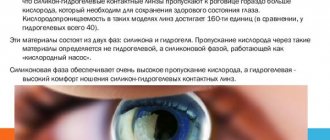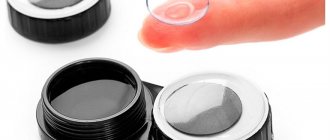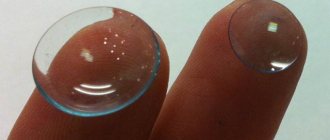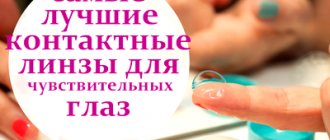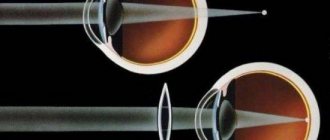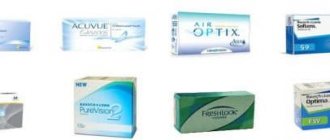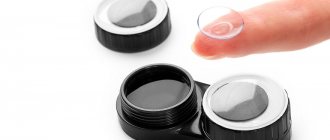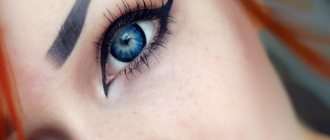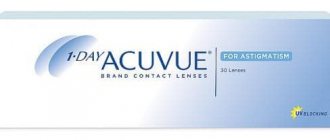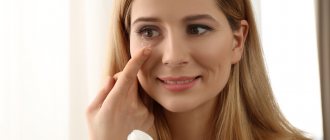A number of different factors contribute to deterioration of vision, among which the most common are considered to be: heredity, long and intense work at the computer, reading, injuries. If until recently vision correction was carried out only through optical glasses, today contact lenses are widely used. Let's look at hydrogel and silicone hydrogel lenses, their inherent pros and cons, which any potential user should be aware of.
Which material to choose
The only difference between the materials is that silicone hydrogel optics contain silicone.
The properties of the materials differ slightly. Oxygen permeability is better in silicone hydrogel vision correction products, but they are stiffer, so wearing comfort is less and adaptation is required. Rigidity appears due to the presence of silicone in the composition.
In addition, they are not suitable for users with allergic reactions to this material.
The main advantage of SGL is oxygen permeability and the possibility of flexible and prolonged wearing. The advantage of GL is its high moisture content, resistance to protein deposits and the purchase of less expensive solutions for disinfection.
Which material to choose depends on the user. If lenses are purchased for long-term or extended wear, silicone hydrogel lenses are suitable. If the patient is more concerned about comfort, quick adaptation and low cost, purchase gypsum plasterboards.
Limbal hyperemia
As mentioned above, redness of the limbus is the most important sign of hypoxia, which appears when using thin hydrogel lenses containing a moderate amount of moisture. Pappas determined the transmittance index value for oxygen, which is critical. Thus, if the index value is more than 125, limbal hyperemia does not appear if the lenses are used only during the daytime. This hypothesis has become something of a cornerstone for advocates of high index lenses. However, there are a number of significant shortcomings of this study. During the mathematical calculations, a deliberately inaccurate method was used. In addition, doubts have been expressed regarding the quality of the control, since the degree of hyperemia was compared with an eye on which a contact lens was not worn. Moreover, in addition to the influence of the index, temperature and mechanical friction from using the lens could influence.
If we look at other studies that compared two brands of silicone hydrogel lenses for continuous and daily wear. At the same time, the index in the peripheral zone was different, but below 125. However, the study did not establish significant differences. This allows us to conclude that an index of 125 is practically clinically insignificant. In addition, even with the minimum index value (37 in the peripheral zone) of silicone hydrogel lenses, no clinically significant hyperemia was detected during daily use.
General characteristics
When you choose daily contact lenses, you need to immediately pay attention to a number of characteristics that relate to them. Here are the main ones:
- Manufacturer. If a company has a good reputation, then there is no doubt that it will offer the highest quality products, created using modern equipment and using high-quality materials. If the company is little-known, then, of course, the lens will still cope with its functions, but you still shouldn’t expect any special quality from it.
- Oxygen permeability. A very important characteristic that is calculated by comparing the volume of oxygen that the lens allows through and the volume that would have reached the cornea of the eye if the lens had not been available. If the oxygen permeability values are high, then the lens is considered high quality and breathable. It is very convenient to use.
- Traditionally, lenses that have a high moisture content are considered the most comfortable. But there is one “but” - during the use of the lenses, moisture evaporates from them. It is also used by eye tissues as one of the sources of oxygen. The result is a burning sensation and a feeling of dryness in the eyes. To combat this problem, special moisturizing components are added to such daily lenses.
- Material. One of the most key characteristics of daily disposable lenses. And here we can distinguish mainly two main options. These are classic lenses that are made from a more traditional hydrogel, as well as newer generation lenses that are based on silicone hydrogel. Both types are used, but the second ones are still the most technologically advanced.
- Stiffness/elasticity. It is this parameter that determines how well the lens follows the shape of the surface of the eye. And it is in this parameter that modern silicone hydrogel contact lenses of the best brands are just slightly inferior to more traditional hydrogel ones.
- Allergy. Silicone is an allergen, so it can provoke allergic reactions. Even if this happens infrequently, it still happens. If you are aware that you personally do not tolerate silicone very well, then you should give preference to hydrogel lenses, which contain a higher amount of soda and are less allergenic.
Read about glasses frames for lenses here.
Vascularization
Vascularization is considered a fairly significant indicator, because in addition to microbial keratitis, this pathological condition poses a real threat to patients who use contact lenses. This disease can occur both during daytime and around-the-clock wearing of CL. Since the formation of vascularization takes a certain amount of time, it does not apply to acute conditions. Data on the occurrence of this process are very variable.
It is known that both lenses with a low transmittance index and thick lenses with a high moisture content can lead to minor vascular ingrowth. But massive vascularization will not occur. There are no examples of the development of hypoxic vascularization during daytime use of silicone hydrogel CLs in the literature.
Scientists led by Dumbleton studied corneal vascularization after long-term (more than 9 months) continuous use of contact lenses. They were able to identify signs of vascularization in patients using contact lenses with low transmittance (less than 10 in the periphery). At the same time, vascularization was absent in patients using CL with an index of 60-100 in the periphery. But the number of studies is not enough, so it is not possible to make a definitive statement.
When wearing CL continuously for a year, scientists led by Brenian found no signs of vascularization in any cornea (212 patients who wore the Acuvue lens in one eye and Pure Vision in the other took part in the examination).
In another study, the same group of authors studied patients using Biofinity, Night & Day, Pure Vision lenses for a year; minor vascularization was identified, which arose during the use of other CLs. After changing the lenses to the ones listed above, the severity of vascularization decreased significantly. At the last visit to the doctor, about 25% of patients using Pure Vision and 21% with Night & Day showed a slight degree of vascularization. At the same time, another scientist (Santodomingo), who studied Night & Day and Pure Vision lenses, does not describe revascularization at all, but only notes the appearance of hyperemia.
Based on these data, it can be said that when using silicone hydrogel contact lenses there are no problems with vascularization resulting from hypoxia.
Hydrogel lenses
The main substance is water, so the lenses are not hard and do not cause discomfort when worn. They retain moisture and form a protective film. They have a small elastic modulus and oxygen transmission coefficient.
Products are manufactured for vision correction. The material used for production does not cause allergic reactions or rejection. It is soft, there is no feeling of discomfort and is not felt on the eyes.
The lenses are thin and do not move or curl when blinking. Do not interfere with the work of the upper eyelid. Hydrogel is an elastic and elastic material that does not cause additional pressure on the cornea.
Wearing period: one day, two weeks, monthly and quarterly, long-term use. The optics have a spherical design, but can also be found with an aspherical one.
Examples of lenses:
- DAILIES AquaComfort Plus;
- Biomedics 55;
- 1 day ACUVUE MOIST;
- Optima FW.
Flaws
Water evaporates quickly when worn, causing discomfort to the user.
Some people have to carry moisturizing drops with them. These vision correction products have low oxygen permeability. This is the main drawback. It does not allow flexible or extended wear of hydrogel lenses.
The contact lens does not have its own blood vessels; the necessary oxygen comes from the air. With prolonged use, hydrogel products lead to oxygen deficiency and the development of hypoxia.
Such optics quickly accumulate protein and fat deposits. It must be washed daily with a special solution.
Which lenses to choose
Reasons to choose hydrogel:
- Do you prefer the one-day regime : every day a new pair and no worries
- You need to constantly moisturize your eyes because you spend a lot of time with gadgets or in front of a monitor.
- You have a sensitive cornea and are concerned about dry eye syndrome
- You already have experience using contact lenses and can handle them easily
- Do you want to use lenses alternately with glasses?
- You lead an active lifestyle , play sports, and often wear makeup, meaning your lenses will be exposed to external influences (sweat, cosmetics)
Reasons to choose silicone hydrogel:
- A planned replacement regime is preferable for you , and you are ready to carefully care for and store your lenses correctly
- Do you want to wear the most modern lenses
- Do you want to try wearing lenses for 7 days without removing them?
- You have already worn hydrogel lenses and noticed that your eyes do not receive enough oxygen and turn red
- This will be your first experience with contact lenses.
- You work a lot , even at night, and are not always sure when exactly your day will end
Advice: Modern products for contact vision correction are absolutely biocompatible, that is, harmless to the eyes. But lenses are still a foreign body, and therefore, constant wearing can slow down the release of tear fluid. This may cause the cornea to dry out and cause discomfort.
But this only occurs in cases where the user wears the lenses for a very long time. If such a problem occurs, you can contact an ophthalmologist or purchase simple moisturizing eye drops at the pharmacy yourself.
Important Tips
A few important nuances and recommendations if you decide to prefer silicone hydrogel solutions.
Although silicone seems to increase conductivity, it is partially blocked by pigment, so it is not recommended to wear such lenses on the eyes for more than 12 hours at a time.
To choose the right type of lenses, you should definitely contact a specialist, but then, knowing what you need, you can base your choice on how well-known and reputable the lens manufacturer is. Do not buy products from unknown companies. You can't go wrong if you buy lenses from Bausch & Lomb, Cooper Vision, Zeiss or other well-known companies that are famous for their quality products.
The best brands of contact hydrogel products
Contact hydrogel lenses vary in wearing regimen: daily, quarterly, and routine replacement products.
One-day
Acuvue 1 Day Moist (manufactured by Johnson & Johnson). They are manufactured using unique LACREON technology, thanks to which the material remains 100% hydrated throughout the day. The eyes will not experience dryness and discomfort. The lenses protect against UV radiation.
Soflens Daily Disposable (manufactured by Bausch + Lomb). High moisture content, elastic, with an aspherical design that eliminates aberrations and maintains clear vision in the twilight. The storage solution contains a special moisturizing component.
Quarterly
Optima FW (manufacturer Bausch + Lomb). Resistant to lipid and protein deposits. Due to the dense structure of the material, even a beginner can handle using them, and this can also extend the adaptation period. It is better to get used to them gradually and not leave them on for long in the first days of wearing them.
Photo 3. Packaging of Optima hydrogel contact lenses from the manufacturer Bausch&Lomb. There are 4 pieces in a pack.
Planned replacement
Proclear (manufactured by Cooper Vision). High moisture content and oxygen permeability, which makes them very comfortable to wear. A coating that is biocompatible with eye tissue is used, the lenses are resistant to deposits, and are approved for dry eye syndrome.
FreshLook Colorblends. Colored lenses with high moisture content. The line includes 24 shades. Suitable for correcting myopia.
Modification of therapeutic silicone hydrogel soft contact lens
The efficiency of drug delivery to ocular tissues has always been a pressing issue in ophthalmology. When using drugs locally in the form of drops, gels, ointments, suspensions, injections and ophthalmic films, it is not always possible to achieve the desired clinical effect in a short time and/or maintain the result without repeated manipulations. This is due to the presence of anatomical and physiological barriers of the eye. The corneal epithelium is one of the main anatomical barriers that prevents the penetration of hydrophilic drugs and macromolecules into the underlying tissue. Another barrier is the corneal stroma, which contains large amounts of hydrated collagen, which prevents the diffusion of highly lipophilic drugs [1]. As a result of absorption into the vessels of the limbal region, partial loss of the drug also occurs [2]. Physiological barriers of the eye include the continuous secretion of tear fluid and its constant change on the ocular surface due to blinking, as well as lacrimation induced by drug instillations. As a result, the cornea absorbs no more than 5% of the initial concentration of the active substance [3]. To increase bioavailability, it is necessary to increase the concentration of the drug or the frequency of its use, which can lead to undesirable side effects and decreased compliance [4]. In order to solve this problem, reduce systemic absorption and improve dosing accuracy, therapeutic soft contact lenses (SCLs) saturated with drugs have been proposed. The bioavailability of drugs when using such lenses reaches 50%, and when instilling drops - only 2–3% [5]. It was first proposed to saturate SCLs with LVs by Wichterle O. and Lim D. in 1965. To implement this idea, they developed SCLs made of poly-2-hydroxyethyl methacrylate. Saturation of SCLs was based on the mechanism of absorption of a hydrophilic drug by a hydrogel; it was carried out by soaking dehydrated lenses in a boric acid solution [6]. The method turned out to be quite simple to use, which made it possible to use it to saturate SCLs made of different materials. Subsequently, many works were published on the saturation of SCL using the method of soaking SCL in solutions of various drugs [7, 8]. Recently, preference has been given to saturating silicone hydrogel SCLs due to their increased oxygen permeability compared to hydrogel SCLs. In order to slow down the release of drugs from the SCL onto the ocular surface, vitamin E was additionally loaded into the lenses. In the experiment, it was proven that the concentration of vitamin E in the lenses does not change over time [9], and the duration of drug release from the SCL, compared with a lens without it increases by 20–100 times for hydrophilic drugs [10] and 7–15 times for hydrophobic drugs [11]. Despite significant progress in this area, difficulties remain associated with the saturation of SCL with high molecular weight and lipophilic substances. Ali M. et al. [12] made an attempt to solve this problem by creating molecularly imprinted SCLs that were saturated with drugs with a high molecular weight: hyaluronic acid and hydroxypropyl methylcellulose. The method assumed the formation of non-covalent interactions and hydrogen bonds between the lens polymer and the drug, due to which the drug was retained in the SCL [13]. Another method was proposed by Chauhan A. et al. [14]. They developed liposomes (spherical containers consisting of a lipid bilayer) and microemulsions containing large drug molecules, which were loaded into SCL. According to the authors, drugs were released from the SCL within 4–8 days, depending on the particle size. Other researchers have proposed modifying the surfaces of SCLs using a polymerization reaction to increase the time it takes for the substance to leave the SCLs [15]. Ciolino JB et al. [16] developed layered MCLs consisting of several layers of different materials and drugs. This structure of the SCL helped slow down the diffusion of the drug onto the ocular surface. Weiner AL [17] patented an SCL in which the PV was contained in a compartmentalized annular cavity running along the edge, in the thickness of the lens. All of the above models of medicinal lenses are characterized by a single mechanism for the release of the drug from the SCL, based on diffusion along the concentration gradient (from the medicinal SCL to the ocular surface). None of the described studies took into account the effect of eyelid pressure on the surface of the therapeutic SCL during blinking, although it has a significant effect on the rate of drug release from the SCL and the total concentration of the substance on the ocular surface [18]. All the lenses described above are characterized by a number of unsolved problems. Firstly, it is possible to lose part of the drug from the SCL due to mechanical and chemical effects during sterilization. Secondly, the issue of storing therapeutic SCLs saturated with the above methods has not been resolved. When such SCLs are soaked in buffer solutions, the drug will diffuse from the lens into the solution. Waite S. [19] proposed a model of therapeutic SCL, which took into account the pressure of the eyelids on the surface of the SCL during blinking as a factor influencing the concentration of the drug on the ocular surface. It contained a module built into the thickness of the lens, the through and non-through holes of which were filled with an optically transparent LV. This structure of the therapeutic SCL made it possible to use it for a long time, periodically oversaturating the drug, and storing the already saturated lens in buffer solutions until required. The main disadvantage of this model was the impossibility of saturating the therapeutic SCL with optically opaque substances due to the localization of the module in the optical zone. The location of the holes on the back surface of the lens made it possible to act only on the underlying tissue. Thus, today the problem of creating a model of therapeutic SCL for saturation with optically opaque and lipophilic drugs, taking into account the influence of eyelid pressure, remains unresolved. Goal of the work:
development of therapeutic SCL that allows the use of optically opaque and lipophilic substances for saturation.
Material and methods:
the lens material is silicone hydrogel.
Lenses are made by sphero-turning using a laser tool. The depot is produced by engraving with a gas CO2 laser at a wavelength of 10.6 microns, radiation power is 30 W. The drug is loaded under vacuum into the SCL depot. Saturated SCLs are sterilized and placed in a buffer solution until required. Results
: a lens model was created, which is a disk with a transparent optical center. It has non-through depots on the periphery from the inside or outside, filled with drugs. The diameter of the lens varies from 14.3 to 15 mm depending on the size of the eye and taking into account the overlap of the limbal zone by the lens. Along the edge, the lens has a chamfer 1 mm wide, with a radius 1 mm larger than the internal radius of the SCL. This form of SCL contributes to minimal displacement during blinking during excursion of the eyeball and an increase in the sublens space. As a result, the drug remains longer in the sublens space, which prolongs its action. Due to the transparent optical center, it is possible to saturate the LV lens with any optical density, which expands the arsenal of applied therapeutic agents, while at the same time allowing to maintain high visual functions. Depots are located on the outer or inner surface of the SCL, depending on the location of the pathological process, which expands the indications for its use. In case of damage to the eyelids and tarsal conjunctiva, the depot should be placed on the outer surface of the SCL, in particular, in an amount of 50–750 pieces, depending on the required concentration of the drug. In this case, the depots are localized in the form of a grid with the exception of the optical center, due to which it is possible to make maximum use of the surface of the SCL and increase the volume of the deposited substance. If the bulbar conjunctiva, cornea, sclera and underlying tissues are affected, it is possible to place depots in ring-shaped recesses passing on the periphery from the inside of the SCL. The number of depots, in particular, ranges from 50 to 300 pieces. and has a width of 1.0 mm. The placement of depots in ring-shaped recesses is associated with possible irritation by micro-notches of the surface of the conjunctival epithelium when they are located on the inner surface of the lens. The number of ring-shaped recesses with built-in depots can vary from 1 to 3 depending on the required drug concentration. Each depot is a hemisphere with micro-notches on its surface and can have a diameter of 100 µm, a depth of 30–40 µm, micro-notches from 5 to 10 µm in length, and a width from 500 nm to 4 µm. The arrangement of the depot in the form of a grid does not deform the shape and surface of the SCL. Micro-notches, due to the surface tension of the solution, help to inhibit the diffusion of drugs from the lens. This depot configuration makes it possible to load a larger number of drugs into the SCL. Localization of the depot on the outer or inner surface of the SCL, depending on the disease, allows for more targeted and dosed delivery of drugs to the affected tissue. Figure 1 shows a schematic representation of a therapeutic SCL with a depot on the outer surface of the lens, where 1 is a chamfer, 2 is a depot filled with LV. Figure 2 shows a therapeutic SCL with a depot on the inner surface of the lens, where 1 is a chamfer, 2 is a depot filled with PV, 3 is a ring-shaped depression with a depot on the inner surface of the SCL.
After placing a drug-saturated SCL on the patient's eye, the drug comes out of the lens under the influence of eyelid pressure during blinking, which is 3–20 mm Hg. Art. The drug concentration on the ocular surface depends on the amount of depots and the frequency of blinking. This allows the effective use of therapeutic SCL for 5–14 days until the depot is completely emptied. To prolong therapy, it is necessary to re-saturate the same SCL with LV. The proposed model of therapeutic SCL can be used for the treatment of various non-infectious ophthalmological diseases that require long-term instillations of drugs, such as chronic blepharitis, dry eye syndrome, keratoconjunctivitis, anterior uveitis, ulcers and corneal dystrophies, glaucoma. We used the lens for the treatment of keratoconjunctivitis sicca and chronic posterior blepharitis. Below are clinical examples.
Clinical example No. 1
Patient M.
, born in 1971. She first contacted the Research Institute of Eye Diseases in 2006. She was diagnosed with OU - severe dry keratoconjunctivitis due to Sjögren's disease, filamentous keratitis, and grade III hypolacrimia. She constantly complained of a foreign body sensation in the eyes, dryness, burning, photophobia, and decreased visual acuity. For many years, she received reparative, tear replacement therapy using various “Artificial Tear” eye drops, which she instilled up to 10 times a day, and periodically dripped corticosteroids. The drops did not have a pronounced positive effect; filamentous keratitis persisted. During examination: visual acuity 0.7 with correction. According to the Schirmer test, the basal secretion was equal to 3 mm on both sides; a decrease in the reflex component to 2 mm was noted. Norn's test was 4 s on both sides. Tests with vital dyes demonstrated staining of the cornea with fluorescein over the entire surface, and with lissamine green staining of the bulbar conjunctiva on the nasal side in the exposed area. The patient was wearing SCLs saturated with cyclosporine A. The diameter of the lenses was 14.5 mm, the base curvature was 8.5 mm, and the diameter of the pupillary zone was 6 mm. PV depots were localized on the inner surface of the lens in 2 ring-shaped recesses in the amount of 500 (250 in each recess). The depots are formed from 100 micro-incisions with a length of 7 and a width of 2 microns. Therapeutic lenses against the background of tear replacement therapy were well tolerated by the patient and did not cause discomfort or irritation in the eyes. Wearing SCLs saturated with 0.05% cyclosporine A made it possible to improve the patient’s condition from the first days of treatment and significantly reduce complaints. After 1 week the lenses were removed. During examination, complete epithelization of the cornea was noted (there was no fluorescein staining of the cornea). Visual acuity increased to 1.0. Positive dynamics were noted according to functional tests: basal secretion according to the Schirmer test increased to 4 mm, Norn test - to 7 s on both sides. The patient was transferred to instillation of a tear substitute.
Clinical example No. 2
Patient N.
, born in 1953. She contacted the Research Institute of Eye Diseases with complaints of redness of the eyes, a feeling of discomfort and burning in the eyes, swelling and redness of the eyelids. History: chronic gastritis with the presence of Helicobacter pylori. After the examination, OU exacerbation of chronic blepharoconjunctivitis was diagnosed. On examination, thickening of the edges of the eyelids, dilation of the vessels of the intercostal margin, swelling of the eyelids and transitional fold, hyperemia of the tarsal and bulbar conjunctiva were noted. When performing tests with vital dyes, total staining of the tarsal conjunctiva and bulbar conjunctiva in the lower quadrant was recorded. The patient was put on therapeutic SCLs saturated with 0.3% ofloxacin. The lens diameter was 14.7 mm, the base curvature was 8.7 mm, and the diameter of the pupillary zone was 7.0 mm. Depots with LVs were localized from the outer surface of the lens to get as close as possible to the affected tissue in the amount of 650. The depots were formed from 50 micro-incisions with a length of 5 and a width of 1 micron. After 2 weeks (when the depot was emptied) the lenses were removed. The patient noted a decrease in the severity of hyperemia, absence of discomfort and burning. During examination, the absence of edema, trace hyperemia of the eyelids and conjunctiva, and the absence of staining of the conjunctiva with vital dyes were noted. The patient was transferred to maintenance therapy, including eyelid hygiene - treating the edges of the eyelids with medicated wipes and moisturizing gel.
Conclusion
: a new model of therapeutic SCL has been developed, which can be saturated with various drugs, including optically opaque and lipophilic ones. This may increase drug exposure time and shorten treatment time.
Rating of the best brands
- Pure Vision 2HD (manufactured by Basch&Lomb) - worn for a month, they minimize the likelihood of glare and other optical effects that interfere with vision. Ideal for night driving and sports.
- Air Optix Night&Day (manufactured by Alcon) - have the highest level of oxygen transmission to the cornea of the eye, which allows you to wear lenses for a month without removing them even at night.
Photo 2. Two packs of Air Optix Night&Day contact lenses from Alcon. 6 pieces each.
- Acuvue Oasys (manufactured by Johnson & Johnson) - two-week old with a high moisture content. Possibility of continuous operation 6 days out of 14.
Thinning of the cornea
A decrease in the thickness of the corneal epithelium and stroma can develop with continuous use of hydrogel contact lenses. If you wear these lenses only during the daytime, the effect is less pronounced. It has not been determined whether corneal thinning can be considered a result of mechanical stress or hypoxia. There is evidence that orthokeratology lenses cause thinning of the cornea exclusively in the central region, regardless of the oxygen transmittance value. Data on the development of corneal thinning while wearing silicone hydrogel CLs have not been published in the literature.
Innovative technologies for increased comfort
Every year new developments appear in the field of vision correction, designed to improve the quality and increase the comfort of wearing optical products. Currently the most popular patented technologies are:
- Hydraclear Plus. Acuvue has included a specialized long-acting moisturizing component in the material. At the same time, additional hydration of the eyelids occurs when blinking, and the protection of the cornea from ultraviolet radiation increases. The product itself has a slight tint, which helps when putting it on: the indicator can be used to determine whether the lens has turned inside out;
- Aquaform Comfort Science. When manufacturing products, the manufacturer Cooper Vision resorts to the use of a unique material that helps reduce the elasticity of the lens and increase the level of oxygen permeability. These are products of improved design, which reduces friction of the lens on the surface of the inner eyelid;
- Intuition. This is technology from the company Acuvue to develop unique “lenses with intuition”. The products are capable of analyzing pupil size and visual acuity, providing clear images at any distance. At the same time, a special moisturizing cushion is created on the lens, protecting the cornea from friction and discomfort;
- ASD. This development from the popular manufacturer Acuvue helps correct astigmatism. The special accelerated stabilization design and structure ensure the desired mobility and fit of the lens on the cornea. At the same time, thin edges of the product are provided under the lower eyelid, which increases wearing comfort.
Most technologies are aimed at improving the convenience of putting on and taking off optics, increasing the period of wearing them and increasing the level of safety of the material itself.
Educational video about modern technology for manufacturing Hydraclear contact lenses:
Rules of care
Lenses are in constant and close contact with the cornea and conjunctiva of the eye and become contaminated with tear and environmental products. In this case, deposits of proteins, carbohydrates and other metabolites, invisible to the naked eye, form on the surface.
Of course, daily lenses are the simplest option, as they do not require maintenance.
But when it comes to long-term wear, it is important to remember: careful care extends the service life and maintains eye health. However, even with careful care, the contact lens needs to be changed once a month.
The more often the CLs are changed, the less dirt and deposits there are on them, and the higher the visual and physical comfort.
The cleansing procedure must be performed immediately after removal. The contact lens is placed on the palm, a special universal liquid is applied to its surface and the front and back surfaces are wiped. Then placed in a storage container
Treatment solution options
When choosing solutions, you need to take into account its shelf life (use only fresh solutions for care), the sensitivity of the body and the type of CL. The main differences are class and allergenicity. Class
is determined by the presence of special components that improve lens cleaning, and allergenicity is determined by the presence of preservatives.
The premium class includes, for example, the hypoallergenic moisturizing solution Synergi. It contains a special component Oxipol, with disinfectant and moisturizing components. Alternatively, you can use a moisturizing solution for all types of Complete Revitalens lenses.
- multi-purpose solution Renu Multiplus;
- Biotrue universal solution;
- Opti-Free Express;
- Likontin solution, etc.
There are no significant differences between premium and economy class solutions; each liquid is suitable for processing lenses. However, there are certain features when selecting a solution if you suffer from allergic diseases.
If you have had allergic eye diseases, then in this case you should use special solutions: AOSEPT (Ciba Vision) or ONE Step (Sauflon). However, here you will encounter another problem. The basis of lens cleaning is the neutralization of the peroxide solution. Complete disinfection requires 6 hours and contact lenses cannot be worn before this time. Until this time, the reaction will not be completed, and this will negatively affect eye health.
In addition to daily care for long-wear lenses, weekly treatment is also used. In this case, enzyme solutions or tablets are used. These substances effectively remove protein products that have accumulated during the week. Cleaning is also done in a closed container. The processing time must be clarified depending on the type of enzyme preparations and moisture content in the CL.
Effective care of vision correction products is not possible in dirty or old containers. Therefore, the lens storage container and tweezers also need to be changed regularly (on average once a month).
Solutions and protein cleaner for such lenses
Hydrogel lenses require regular care. In this case, special solutions will come to the rescue. They effectively remove protein deposits that are typical for the products in question. Lipid deposits form on soft ones and solutions that are not intended for such models will be ineffective. And their use can lead to staining of the cornea. In this case, you should stop using the product and choose more modern medications for care.
The following products are effective:
- Cleaners containing alcohol (must be marked “AOFlow”, “MiraFlow”), in combination with multifunctional solutions.
- Peroxide systems for cleaning and disinfection – One Step, Aosept plus.
- Multifunctional solutions that provide additional moisturizing during mechanical cleaning and washing - OptiFree Replenish, OptiFree Pure Moist, OptiFree Express, Biotrue, Synergi, Renu MPS and Renu Multiplus, Likontin Neo, Likontin Neo Multi, Likosol 2000.
Silicone hydrogel lenses: what are they?
- High oxygen transmission capacity to the cornea. This eliminates the occurrence of oxygen starvation of the eyes.
- They keep their shape perfectly, so peripheral vision does not deteriorate.
- Used for farsightedness, myopia and astigmatism.
- Allowed for use by children.
Advantages:
No dryness or discomfort. Some people, when wearing hydrogel products, have red eyes in the evening, a feeling of dryness and “sand” on the cornea. Symptoms intensify with long hours of work at the computer, and arise due to dehydration (dehydration) of the lenses. Silicone hydrogels are not subject to dehydration, so even at the end of the day the eyes do not get tired. Easy to put on and take off. This type of optics holds its shape well and is easier to remove and put on.
This is especially important for people who have had difficulty using fragile hydrogel products. Low levels of sediment accumulation
The products accumulate much less lipid and protein deposits, which means comfort and excellent vision throughout their service life.
Flaws:
There are cases of individual intolerance to silicone, which causes an allergic reaction, redness of the organs of vision, and burning. There is no need to immediately buy lenses designed for monthly use. It's best to start with daily or weekly ones to make sure they fit exactly.
- It takes longer for your eyes to get used to silicone hydrogel lenses. This is due to the increased strength and elasticity of the material.
- It is not recommended to engage in dynamic sports, especially exercises with flips and jumps. Lenses may fall out or cause eye injury due to the increased strength of the material.
- For some people, the ability to wear contact lenses for a long time turns into a disadvantage. The eyes get used to it, and the person simply forgets about the change.
Important! When choosing silicone hydrogel optics with a service life of a week, two or more, without removing them, you must remember when to replace them with new ones. Using products for a long time after their expiration date has expired will result in significant visual impairment or even the need for surgery.
Features of colored lenses
Colored contact optics have the same properties as regular ones, but with its help you can change your appearance, emphasize the color of your eyes, making it bright. For example, change the tone of brown to blue or green. The dye in the products is embedded inside the material and does not come into contact with the cornea.
Edema, stretch marks, endothelial folds
The existence of a connection between oxygenation and oxygen delivery to corneal cells has been known for a long time. When using contact lenses with an oxygen transmittance index of less than 20, corneal edema occurs, even with open eyelids. If the severity of edema is more than 5%, the doctor, during examination, may reveal the presence of striae in the posterior layers of the stroma. If the swelling is more than 10%, endothelial folds may appear. All silicone hydrogel lenses are free of this side effect and do not lead to corneal swelling when worn with open eyelids.
At night, when the eyelids are closed, slight swelling of the cornea occurs, even in people who do not use contact lenses. Its degree is 0.7-5.5%. In patients using contact lenses, swelling is expressed differently. Scientist Cox and co-authors found that swelling occurs in 3.8% of people without contact lenses, in 2% of patients using hydrogel lenses only during the day, in 0.7% with continuous wearing of hydrogel contact lenses.
In the case of closed eyelids, absolutely all CLs increase swelling of the cornea. Thin hydrogel contact lenses, which have an average moisture content, increase swelling by an average of 8%; with a lower lens transmittance value, this figure increases to a greater extent.
Silicone hydrogel lenses result in significantly less corneal edema. At the lowest index value, lenses approved for permanent use (Pure Vision) cause swelling only 2% more than normal. At the highest value of transmittance, this figure is only 1% higher than normal. To date, the question of whether an increase in the degree of edema by 1 or 2% is clinically significant and whether this is an indicator of hypoxia has not been finally resolved. Due to the lack of a clear connection between the swelling of corneal cells and the formation of pathological changes, it can be argued that the use of silicone hydrogel contact lenses does not cause pathologies of the eyeball.
In case of discomfort from wearing
Why night lenses are dangerous, see the material.
Even properly fitted daily contact lenses can be a noticeable cause of discomfort. Therefore, you don’t need to endure, you don’t need to think that everything is fine, you should definitely contact a specialist if the slightest, even minimal discomfort occurs.
- If your eyes see a little worse, you need to contact a specialist immediately.
- If you have the feeling that there is something in front of your eyes, this is not normal, it means that the lenses most likely do not suit you in some way.
- If irritation appears, it also needs to be dealt with urgently, otherwise a serious problem may arise that will lead to vision gradually deteriorating.
Read about the best eye drops for lenses here.
Law of Diminishing Returns
This law must be kept in mind when considering the relationship between the value of the transmittance index and the oxygen supplied to the corneal layer. Suppose that a contact lens with an index of 100 results in an oxygen concentration on the corneal surface that creates a partial pressure of 100 mmHg. Under normal conditions, with the eyes open, a doubling of the index will not be accompanied by an increase in partial pressure to 200 mm Hg. This is not possible from a physics point of view. The partial pressure of oxygen on the cornea cannot exceed the value of this parameter at sea level (159 mmHg). Therefore, no matter how hard the developers try, the partial pressure of oxygen will not exceed this value.
In studies by Bonanno and co-workers, it was found that the level of oxygen pressure at the anterior surface of the cornea increases significantly until the transmitting index exceeds 85. As the index increases further, the benefits are not very significant. In this case, the law of diminishing returns applies.
The question remains unresolved about the level of the transmittance index, after an increase in which no real clinical improvement will follow. Thanks to studies of oxygen consumption, it can be assumed that this level is lower than the index value for any of the silicone hydrogel CLs.
When studying the effect of oxygen concentration on corneal tissue, a number of parameters must be taken into account simultaneously. Do not forget that the oxygen transmittance value indicated in the annotation is relevant only for the central part of the lens. For example, if the index value is 20, then in the central region it is the same, while in the periphery it can be two or more times lower. The index values for the central and peripheral areas of the retina, which are presented in the table, were obtained in the course of a study by Bruce, Efron and some other authors. At the same time, the value of the maximum transmittance does not always coincide with the official indication of the manufacturer, since in the latter case they indicate the average value for a lens with an optical power of -3 diopters.
In clinical practice, it is known that oxygen transmittance varies with lens thickness. The last parameter may vary depending on the optical power. However, most manufacturers limit the maximum thickness of contact lenses (about 0.3 mm), despite the different diopter values. Therefore, a similar statement is valid for interpreting the lowest transmittance index value for lenses with high optical power.
Due to the fact that the thickness of special lenses (in particular, toric ones) differs slightly from ordinary lenses, all these statements are true for them. If there is no special mark, then all transmittance data are given for the central region of the retina. Among silicone hydrogel lenses, Pure Vision and Acuvue Advance have the minimum index value, which are used for continuous and daytime wear, respectively. In this regard, these lenses are discussed below.
Complications associated with hypoxia
Essentially, all hydrogel contact lenses result in insufficient oxygen supply to the cornea. Even a short-term presence of such a lens on the surface of the eyeball, covered by the eyelids, causes swelling of the corneal cells, hyperemia of the limbus, and the formation of specific bubbles in the endothelium. With continuous use of hydrogel CLs, microcysts and vacuoles are formed, thinning of the stroma, vascularization of the cornea, an increase in the degree of myopia, and endothelial polymegatism appear.
In the case of open eyelids, these lenses do not cause such consequences, however, the data obtained suggest that even in this case there are changes in the cornea on some part of the surface, since hypoxia of varying severity is always present.
The most noticeable manifestation of hypoxia is limbal redness, which can be found in most patients wearing hydrogel lenses. Even long-term wearing of CLs only during the daytime leads to polymegatism of the endothelium.
Lenses with low transmittance (index less than 20) lead to the development of corneal edema, even against the background of open eyelids. If the index value is less than 10 in the peripheral areas, then vascularization also develops. In this regard, we can conclude that with a high index value, the effect on the corneal tissue is minimal. However, even the use of such lenses is often accompanied by limbal hyperemia.
Due to the fact that most patients use hydrogel lenses with an index of 20 in the central zone, it can be assumed that the most pressing problem is the elimination of redness of the limbus. That is why the use of hydrogel lenses should be replaced with silicone hydrogel ones.
Terms of use
- Before putting on or removing contact optics, you should thoroughly wash your hands with soap and dry with a lint-free towel.
- You cannot wear the product even one day longer than the service life specified in the instructions.
- Do not allow creams, perfumes, hairspray, other aerosols and substances, or decorative cosmetics to come into contact with the optics.
- If dry eyes appear, you should consult an ophthalmologist; you cannot select drops yourself.
- A visit to the doctor twice a year is required in case of constant use of the products.
Rules of care:
- After removal, rinse each side of the lens with a special solution and lightly rub it with clean, washed fingers to remove protein deposits.
- Change the liquid in containers for storing optics every day; it cannot be reused.
- Change the container when opening a new bottle of cleaning solution.
- Do not touch the dropper tip of the bottle to your hands or any surfaces to prevent germs from getting into the solution.
- After each use, close the bottle tightly, do not place it on the windowsill, near the radiator, i.e. in places where the liquid can overheat.
Storage solution
Most suitable: Maxima, Synergi or Unica Sensitive. Designed specifically for silicone hydrogel products.
Photo 1. Two different packages of Unica Sensitive disinfectant solution from Avizor with a storage container.
In addition, you can use universal liquids that are suitable for all types, for example, VizoTeque Giasol, Biotrue, Renu Multiplus.
Advice. The solution is selected only after selecting lenses. An ophthalmologist will help you with your choice.
General diagnostics
To select lenses, a specialist will conduct a thorough examination of the organ of vision according to the following parameters:
• general eye condition,
• diopter value,
• intraocular pressure,
• curvature of the cornea,
• peripheral vision,
• work of the oculomotor muscles.
Based on the results of the diagnosis, a method of vision correction will be prescribed, after which you can proceed directly to the selection of lenses, taking as a basis the recommendations of the ophthalmologist and your own preferences. An important point: after selection, the ophthalmologist will teach you how to put on and remove lenses, talk about proper care for them, give detailed recommendations, and also set the date for the next consultation.
About contact lenses
Correction of impaired vision can be done by wearing glasses, contact lenses, or surgery (however, surgical treatment is not always necessary). Despite all the advantages, wearing glasses for vision correction also has a number of disadvantages - for example, limited peripheral vision or moisture accumulation in the rain or under other unfavorable conditions, and the aesthetic side does not suit everyone.
An excellent solution to this situation would be contact lenses. They are completely invisible to the eyes; the “bespectacled person” complex, which usually affects small children and schoolchildren, does not occur in a child wearing lenses. Modern models, unlike their historical predecessors, are mostly comfortable to wear, provide nutrition to the cornea and do not cause a foreign body sensation.
Increased degree of myopia
It is known that while wearing hydrogel lenses, the degree of myopia increases slightly, and it increases more rapidly than when using spectacle correction. This negative effect is absent when wearing silicone hydrogel CLs. There is a hypothesis according to which the growth of the eyeball is ensured by the peripheral refraction of the retina. When using standard lenses, the nature of optical aberrations changes, which leads to increased myopia when compared with spectacle correction. This effect can be compensated by using rigid silicone hydrogel lenses, which will mechanically lead to flattening of the central region of the cornea.
Features of hydrogel lenses
Optical products based on hydrogel are in great demand due to their composition and lack of discomfort even during long-term wear.
Compound
To manufacture the presented models, hydrogel polymers (special gel and water) are used. These materials provide comfortable wearing as they are compatible with ocular tissues.
Thanks to innovative technologies, it has become possible to use not only one polymer in manufacturing, but also to combine it with others. You can also include a number of auxiliary components in the composition, including hyaluronic acid. It promotes eye hydration and comfort.
